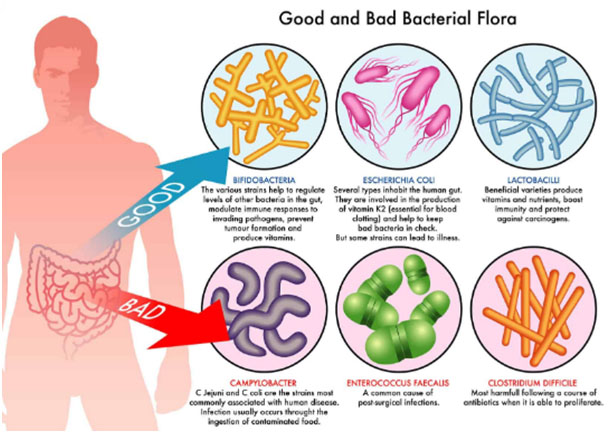Microbiota Or Gut Flora

The gut microbiota used to be called the microflora of the gut.
Human gastrointestinal microbiota, also known as gut flora or gut microbiota, are the microorganisms (generally bacteria and archaea), that live in the digestive tracts of humans.
Our gut microbiota contains tens of trillions of microorganisms, including at least 1000 different species of known bacteria with more than 3 million genes (150 times more than human genes).
Microbiota can, in total, weigh up to 2 kg. One third of our gut microbiota is common to most people, while two thirds are specific to each one of us. In other words, the microbiota in our intestine is like an individual identity card.
As its name states, gut microbiota is harboured in the intestine, one of the main areas in our bodies that comes into contact with the external environment (other examples are the skin and the lungs).
Some of the functions are:
The gut microbiota of each individual is unique. It can heavily contribute to how a person fights disease, digests food, and even their mood and psychological processes.
- It helps the body to digest certain foods that the stomach and small intestine have not been able to digest.
- It helps with the production of some vitamins (B and K).
- It helps us combat aggressions from other microorganisms, maintaining the wholeness of the intestinal mucosa.
- It plays an important role in the immune system, performing a barrier effect.
- A healthy and balanced gut microbiota is key to ensuring proper digestive functioning.
- Gut bacteria help us break down complex molecules in meats and vegetables. Without the aid of gut bacteria, plant cellulose is indigestible.
- The microbiota can affect the brain, which is also involved in digestion. Some have even called the gut microbiota a “second brain.”
- It is also helpful in gut conditions, including inflammatory bowel diseases (IBD), such as Crohn’s disease and ulcerative colitis, as well as obesity and type 2 diabetes.
- The microbiota also plays an important role in resisting intestinal overgrowth of externally introduced populations that would otherwise cause disease – the “good” bacteria compete with the “bad,” with some even releasing anti-inflammatory compounds.
Here are some tips to get your gut going
- Increase your fibre intake
- Eat as many types of fruit and veg as possible, and try to eat seasonally
- Pick high-fibre vegetables
- Choose food and drinks with high levels of polyphenols
- Avoid snacking
- Eat plenty of fermented foods containing live microbe
- Include foods rich in probiotics and prebiotics